Related Research Articles
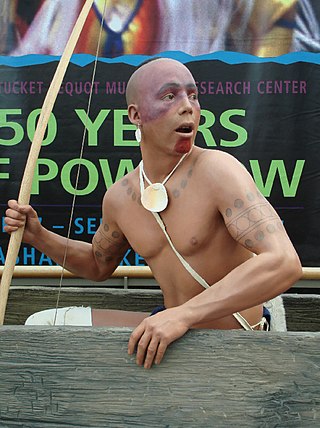
The Pequot are a Native American people of Connecticut. The modern Pequot are members of the federally recognized Mashantucket Pequot Tribe, four other state-recognized groups in Connecticut including the Eastern Pequot Tribal Nation, or the Brothertown Indians of Wisconsin. They historically spoke Pequot, a dialect of the Mohegan-Pequot language, which became extinct by the early 20th century. Some tribal members are undertaking revival efforts.
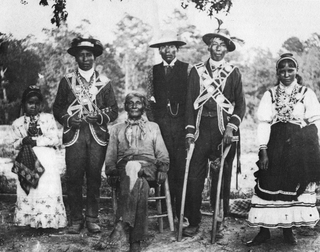
Choctaw mythology is part of the culture of the Choctaw, a Native American tribe originally occupying a large territory in the present-day Southeastern United States: much of the states of Mississippi, Alabama, and Louisiana. In the 19th century, the Choctaw were known to European Americans as one of the "Five Civilized Tribes" even though controversy surrounds their removal.

King Philip's War was an armed conflict in 1675–1676 between a group of indigenous peoples of the Northeastern Woodlands and the English New England Colonies and their indigenous allies. The war is named for Metacomet, the Pokanoket chief and sachem of the Wampanoag who adopted the English name Philip because of the friendly relations between his father Massasoit and the Plymouth Colony. The war continued in the most northern reaches of New England until the signing of the Treaty of Casco Bay on April 12, 1678.
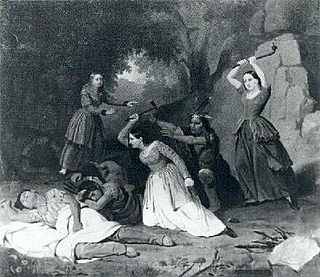
Hannah Duston was a colonial Massachusetts Puritan woman who was taken captive by Abenaki people from Quebec during King William's War, with her newborn daughter, during the 1697 raid on Haverhill, in which 27 colonists, 15 of them children, were killed. In her account she stated that the Abenaki killed her baby soon after they were captured. While detained on an island in the Merrimack River in present-day Boscawen, New Hampshire, she killed and scalped ten of the Native American family members holding them hostage, with the assistance of two other captives.
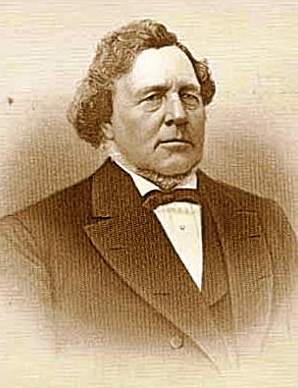
George Albert Smith was an early leader in the Latter Day Saint movement. He served in the Quorum of the Twelve Apostles and as a member of the First Presidency of the Church of Jesus Christ of Latter-day Saints.
Praying Indian is a 17th-century term referring to Native Americans of New England, New York, Ontario, and Quebec who converted to Christianity either voluntarily or involuntarily. Many groups are referred to by the term, but it is more commonly used for tribes that were organized into villages. The villages were known as praying towns and were established by missionaries such as the Puritan leader John Eliot and Jesuit missionaries who established the St. Regis and Kahnawake and the missions among the Huron in western Ontario.
In Irish mythology Tír na nÓg or Tír na hÓige is one of the names for the Celtic Otherworld, or perhaps for a part of it. Tír na nÓg is best known from the tale of Oisín and Niamh.

The Sword of Light or Claidheamh Soluis is a trope object that appears in a number of Irish and Scottish Gaelic folktales. The "Quest for sword of light" formula is catalogued as motif H1337.

George Lyman Kittredge was a professor of English literature at Harvard University. His scholarly edition of the works of William Shakespeare was influential in the early 20th century. He was also involved in American folklore studies and was instrumental in the formation and management of the Harvard University Press. One of his better-known books concerned witchcraft in England.
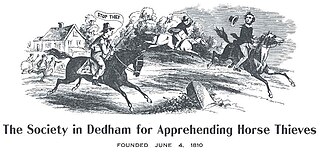
The Society in Dedham for Apprehending Horse Thieves is one of the "oldest continually existing horse thief apprehending organization in the United States, and one of Dedham's most venerable social organizations." Since its founding there have been more than 10,000 members including heads of state, Supreme Court justices, governors, popes, professors, generals, and other notables.

The history of Dedham, Massachusetts, 1635–1699, begins with the first settlers' arrival in 1635 and runs to the end of the 17th century. The settlers, who built their village on land the native people called Tiot, incorporated the plantation in 1636. They sought to build a community in which all would live out Christian love in their daily lives, and for a time did, but the Utopian impulse did not last. The system of government they devised was both "a peculiar oligarchy" and a "a most peculiar democracy." Most freemen could participate in Town Meeting, though they soon established a Board of Selectmen. Power and initiative ebbed and flowed between the two bodies.
Joseph Bruchac is an American writer and storyteller based in New York.

Nathaniel Ames, a colonial American physician, published a popular series of annual almanacs. He was the son of Nathaniel Ames first (1677–1736) and the father of Nathaniel and Fisher Ames. The family was descended from William Ames of Bruton, Somerset, England, whose son William emigrated to Massachusetts and settled at Braintree as early as 1640.
There are a vast array of myths surrounding the Blackfoot Native Americans as well as Aboriginal people. The Blackfeet inhabit the Great Plains, in the areas known as Alberta, Saskatchewan, and areas of Montana. These stories, myths, origins, and legends play a big role in their everyday life, such as their religion, their history, and their beliefs. Only the elders of the Blackfoot tribes are allowed to tell the tales, and are typically difficult to obtain because the elders of the tribes are often reluctant to tell them to strangers who are not of the tribe. People such as George B. Grinnell, John Maclean, D.C. Duvall, Clark Wissler, and James Willard Schultz were able to obtain and record a number of the stories that are told by the tribes.

Calila e Dimna is an Old Castilian collection of tales from 1251, translated from the Arabic text Kalila wa-Dimna by the order of the future King Alfonso X while he was still a prince. The Arabic text is itself an 8th-century translation by Ibn al-Muqaffa' of a Middle Persian version of the Sanskrit Panchatantra from about 2nd-century BCE.

Kamaal Dhamaal Malamaal is a 2012 Hindi-language comedy drama film directed by Priyadarshan. It stars Nana Patekar, Paresh Rawal, Om Puri, Asrani, Shreyas Talpade, Shakti Kapoor and Nyra Banerjee. The film has been produced by Percept Picture Company. The story is adapted from Malayalam film Marykkundoru Kunjaadu written by Benny P. Nayarambalam. It was released on 28 September 2012. This film is the reboot of the 2006 comedy film Malamaal Weekly.
Peter Jethro was an early Native American (Nipmuc) scribe, translator, minister, land proprietor, and Praying Indian affiliated for a period with John Eliot in the praying town of Natick, Massachusetts.
Captain Samuel Hunting was a military officer from Massachusetts who served in King Phillip's War.
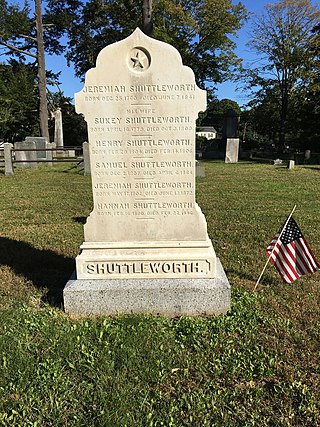
Jeremiah Shuttleworth was a merchant and postmaster from Dedham, Massachusetts.
Captain Samuel Mosley or Moseley was a New England settler and militiaman.
References
- 1 2 3 Kittredge, George Lyman (1920). The Old Farmer and His Almanack. Cambridge, Mass: Harvard University Press. pp. 243.
the old farmer and his almanack.
- ↑ Caverly, Robert Boodey (1875). Heroism of Hannah Duston. Boston, Mass: B. B. Russell & Co. pp. 121.
Heroism of Hannah Duston.
- ↑ McKnight, Charles (1902). Our Western Border. Chicago, Il: Educational Company. pp. 752.
- ↑ Wimer, James (1841). Events In Indian History. Lancaster, Pa: G. Hills & Co. pp. 498.
Events in indian history.
- ↑ Hubbard, William (1803). Narrative of the Indian Wars in New England (1607-1677). Stockbridge, Mass: Heman Willard. p. 223.